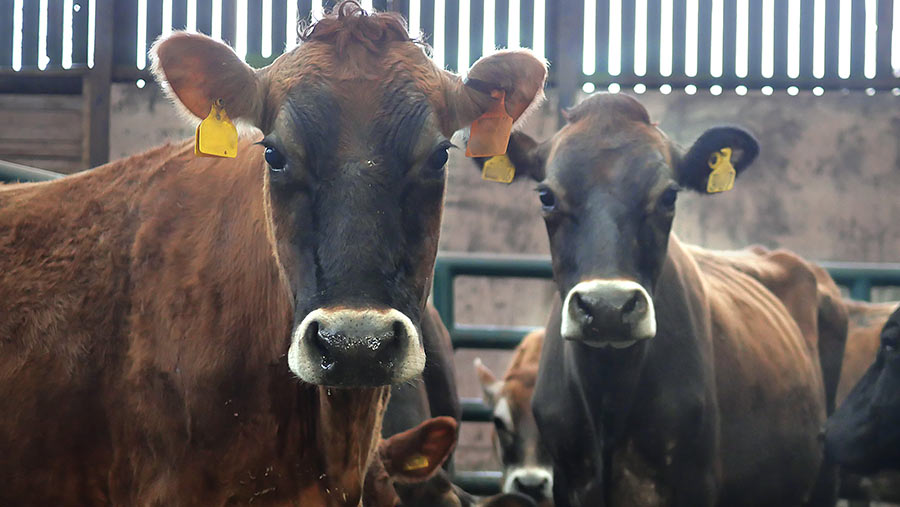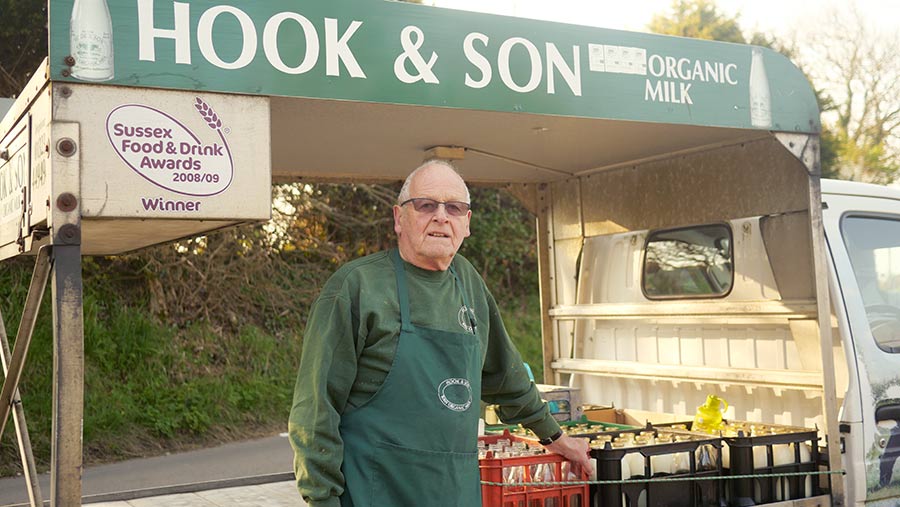Video: So you want to… sell milk direct from farm?

Liquid milk is going through an identity crisis. Unchanged branding in supermarkets and limited marketing means dairy alternatives have stolen a march on the white stuff.
AHDB Dairy research agrees, but says consumers are not consciously turning away from dairy – rather they are more excited by the branding and choice of non-dairy drinks like almond, oat and soya “juice”.
See also: Map: Where to buy milk direct from farm
As volatility shows no signs of abating, proponents of change, including Nuffield scholar Tom Levitt, are calling for an own-label milk revolution to shake up the industry.
“If the dairy industry wants to make consumers value, desire and pay more for milk and dairy, it has to invest in the ways it can achieve that: namely brands and innovation,” says Mr Levitt.
Shedding a supply contract can eliminate milk price volatility for producers and add significant value back into milk, often many times higher than what dairy farmers receive from a processor.
However, taking production in-house requires producers to expand their skills beyond just being experts in milk production.
As well as requiring substantial capital for taking processing in-house, dairy farmers who want to sell their own milk must also become skilled at marketing, selling and logistics.
What is the market like now?
Despite negativity surrounding the direction of the industry, UK dairy farmers are in an advantageous position.
Statistics on farmers who have taken the leap to selling milk direct from the farmgate are scarce, but AHDB Dairy estimates about 200 producers – 2% of all UK dairy farmers – sell some or all of their milk from the farmgate.
Consumption statistics are also very positive. Dairy UK says 96% of adults buy milk and 80% consume it regularly.
What is the market outlook?
Prospects for branded dairy are on the up. Many retailers and processors are introducing more branded milk lines after decades of colour-coded supermarket-own label bottles dominating shelves.
Asda has recently revamped its dairy offering to feature more local brands and Arla is increasingly branding milk products, such as its BOB (Best of Both) fat-free skimmed milk line.
Figures from Kantar Worldpanel show that despite making up just 16% of the total amount of milk sold in the year ending March 2019, branded milk accounted for nearly one-quarter of the value of the liquid market.
Branded milk’s proportion of the market has grown over the last three years both in terms of volume and value, highlighting a shift away from the traditional red, green and blue top offering.
What permissions are required?
Health and hygiene regulations are tight when selling milk from the farmgate and even stricter if you decide to sell raw milk.
Raw milk regulations
For specific advice on selling raw milk visit the FSA website
Inspections can vary between country and region for selling pasteurised milk.
Producers can expect an initial parlour and processing room inspection from Environmental Health and the Food Standards Authority (FSA), followed by subsequent check-ups about every nine months.
Some vendors have reported increased inspections while the businesses become established, with checks then becoming less frequent as trust is built between the farm and inspection bodies.
Being a member of farm accreditation schemes such as Red Tractor or Pasture Promise will involve further check-ups.
A lot of time and money can be saved by having a good working relationship with inspectors and using them for advice and guidance.
What are the essential requirements?
Fundamentally, the ability to process and bottle your milk into a saleable condition is required to sell milk directly.
This could either be through a vending machine, or in plastic or glass bottles.
The majority of enterprises will require a processing room containing expensive machinery such as a pasteuriser, butter churn, cream separator, bottle machine and bottle washer (see “Approximate prices for second-hand processing kit” below).
A bottling machine is not essential, but can save many hours compared with hand filling.
Each additional product line usually requires an added piece of equipment, which will need to be justified with a cost/benefit analysis before buying.
Purchasing equipment second-hand can save thousands of pounds for businesses just getting established.
Processing rooms themselves need to meet FSA specifications, centred around cleanliness and suitability for food production.
Approximate prices for second-hand processing kit
- Bottling machine: £20,000
- Bottle washer: £6,000
- Pasteuriser: £20,000
- Butter churn: £1,000
- Ghee maker: £4,000
- Ice cream maker: £18,000
- Industrial fridge: £1,500
- Blast freezer: £2,700
Marketing
Building a brand and having a website are pre-requisites of modern businesses and are important to garner repeat customers.
Producers do not need to spend a fortune on either, nor hire expensive professionals. If paying someone else, ask around and find a professional who comes highly recommended from trusted friends.
If you decide to do branding in-house, keep logos simple and easily identifiable at any size.
A regularly updated social media presence is essential to stay in touch with customers and to tell the farm story, adding value back into the milk.
How long until I see a return?
Cashflow depends entirely on marketing and market research.
Providing there is demand in the area and the product is right, returns will be immediate.
Other important considerations
Follow consumer retail trends. Recent months have seen people return to the nostalgia of a local milkman and turn to glass bottles to improve their environmental footprint.
Dairy products follow similar crazes. Kefir, ghee and ice cream can all be made relatively cheaply, but attract excellent margins above and beyond liquid milk.
Case study: Sam and Katie Bullingham Taw River Dairy, Okehampton Devon
Sam and Katie Bullingham began Taw River Dairy as they wanted to combine an interest in sustainability with sharing an ethical farm story with consumers.
Mr Bullingham admitted he knew from the off he did not want to go down the supermarket route with the farm’s organic, pasture-fed, non-homogenised milk, ice cream and cream.

Sam and Katie Bullingham
The farm’s milk retails for £1.50-£1.80/litre, while ice cream sells for £2.50/125ml (£2.00/litre). The dairy enjoys better margins on scoops of ice cream at events, which can be sold for £2.50/60ml (£4.16/litre).
“If you do exactly the same as retailers then you are competing with them on price and there is no point doing the extra effort,” says Mr Bullingham.
The dairy farmer’s passion to differentiate his milk has led him down the path of being an ethical, organic and grass-fed dairy.
The latter means cows are milked just once a day, leaving the remainder for calves, which remain alongside their mothers, losing yields of between 500-1,000 litres a cow over a lactation.
Resurgence of milk in glass
The route has been a success because people are prepared to pay more for quality and a product that resonates with them, says Mr Bullingham.
“We sell milk in glass bottles, which have seen a resurgence in the public imagination in recent months.
“We also have a direct milk round to make the most of consumers’ desire for convenience. You need to keep up with retailing trends while sticking close to your principles,” he adds.
The dairy initially banked on ice cream, with its excellent margins, being its biggest seller.
However, the seasonal nature of the market meant growth in the business came from liquid milk.
Correct marketing crucial
When it comes to marketing, Mr Bullingham says it is easy to get bogged down in the tech stuff, but getting it right is crucial.
“We chose the wrong web designer, which cost us £1,500. In the end we went with someone who came highly recommended and I did the branding myself.
“You need to consider all of these new avenues before going down this route,” says Mr Bullingham.
Top tips
- Decide on your principles and stick to them rigorously
- Find a point of difference to separate yourself from the competition
- Piggyback on popular trends such as glass bottles and milk delivery
- Diversify into different products that add further value to the brand
- Buy second-hand kit for the parlour to save thousands
Case study: Steve Hook, Hook & Sons, Hailsham East Sussex
South Downs dairy farmers the Hooks know better than most how to adapt quickly to changing markets.
TB restrictions prevented the farm from selling its primary product – raw milk – forcing them to diversify into other items and markets in order to stay open.

Phil Hook
Since coming down with TB restrictions more than 12 months ago, the farm had to invest in a second-hand pasteuriser, cream churn and butter churn, costing £20,000, £6,000 and £1,000, respectively.
“Without the TB, we would have never dipped our toe into new areas or given different things a go,” says Steve Hook.
The investment, bolstered by a grant that is no longer available, allowed the farm to produce a range of pasteurised products to keep cash flowing and maintain its extensive customer base.
Creating a loyal brand
“We’ve managed to keep 90% of our customers despite the majority wanting raw milk.
“I think we have done this because we have created a brand loyalty and farm story that our customers trust and have bought into over the years. It is really invaluable,” adds Mr Hook.
The farm sends out a monthly newsletter to its thousands of customers and maintains an active social media presence to keep customers updated with the latest farm news.
Revenue is divided into three primary streams: wholesaling milk by courier nationwide, nine doorstep milk delivery services and 16 farmers’ markets, both in the immediate area and in London.
“London has proven a real success for the farm,” says Mr Hook.
“Customers in the capital want an authentic, high-quality product with a strong back story and good credentials.
“Buyers love going to their local market and having a chat with a farmer about how the cows are and what it is like on the farm – it is a bit of escapism for them,” he says.
Affluent market
The more affluent market allows the farm to sell milk for an extra 25%, but incurs its own costs in manpower and transport.
“Every added stream we get into adds to the burden on logistics, staff and cashflow,” says Mr Hook.
The farm has about 6,000 poly and glass bottles in circulation at any time, with a fleet of vans, milk floats and couriers moving Hook milk across the UK.
More growth to be found
But, Mr Hook adds, if the milk is right and its organic and grass-fed principles are strong, there is growth to be found right across the country.
“Selling milk to customers has really galvanised my faith in humanity. We get letters of support from buyers all the time saying how much they value our milk, and many have helped to keep us afloat.”
Hook & Sons raised more than £28,000 through a crowdfunding campaign to mitigate the financial loss of selling raw milk when TB restrictions were imposed.
Top tips
- Forge strong relationships with your customer base, as customer loyalty is everything.
- Cleanliness is critical with raw milk, so an understanding of microbiology and pathogens is key.
- Do not try to compete with anyone on price. It is important not to undersell milk, as it hurts the whole industry.
- Have a forensic knowledge of milk so you can share its story with consumers.
